Häcken entered the international break on the back of a five-game winning streak which propelled them to the summit of the Swedish Allsvenskan. The Gothenburg side’s impressive form includes wins over AIK and last season’s Champions League group stage participants Malmö.
The Wasps are managed by Former Djurgårdens and Norway national team manager Per-Mathias Høgmo. This will be Høgmo’s first full season in charge having been appointed in June 2021. With a 12th placed finish to last season, Häcken’s form has improved greatly this year. They are just two wins away from equaling their win total from the whole of the 2021 campaign.
This analysis will be presented in the form of a scout report focusing on Häcken’s build-up play and how they press from a mid-block. In this tactical analysis, we analyse the key tactics behind Häcken’s meteoric rise to the top of the league.
Statistical analysis
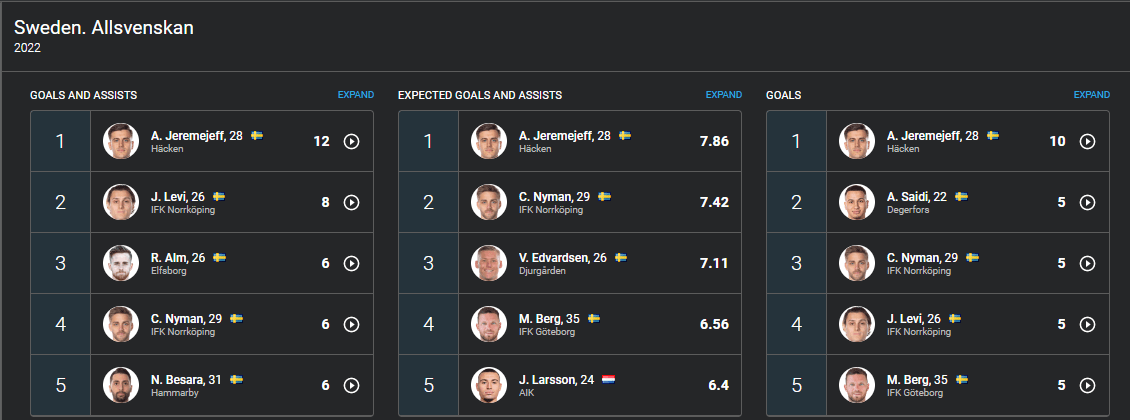
The above image shows the Allsvenskan’s top players for league ‘goals and assists’, ‘expected goals and assists’, and ‘goals’. Häcken’s number ‘9’ Alexander Jeremejeff leads the way on all three and is a key reason for the success of his side this year. With 10 goals the former 2. Bundesliga striker is just one shy of his league total from last year.
As a team, Häcken have scored 22 goals, the most in the division, and have an xG for 21.82 goals. This means they are scoring as many goals as the quality of their chances deserves. The only team with a higher xG is AIK who, with an xG of 22.30 and only 17 goals scored, are underperforming their xG by 5.3 goals.
Häcken average 49% possession and an average of 400 passes completed per 90 minutes in league matches this term, placing them ninth out of 16 teams for both. As will be covered in the next sections, this is because they are comfortable without the ball rather than an inability to hold on to possession.
Build-up play
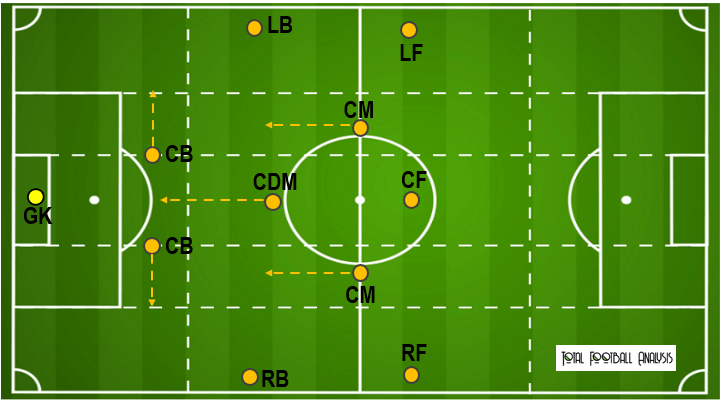
As shown in the tactical diagram above, Häcken build-up in a 4-3-3. The front three stay high and wide to both stretch the opposition back-line and prevent them from squeezing the space in the midfield.
A key part of their build-up play is the positioning of their midfield three, who all occupy different vertical lanes. The defensive midfielder often drops between the centre-backs with the central midfielders staying high and in the half-spaces.
The centre-backs split wide to receive the ball and to allow the single pivot, or defensive midfielder, to drop between them, and the full-backs keep very wide.
This section is going to analyse a few elements of Häcken’s build-up play that make it so effective.
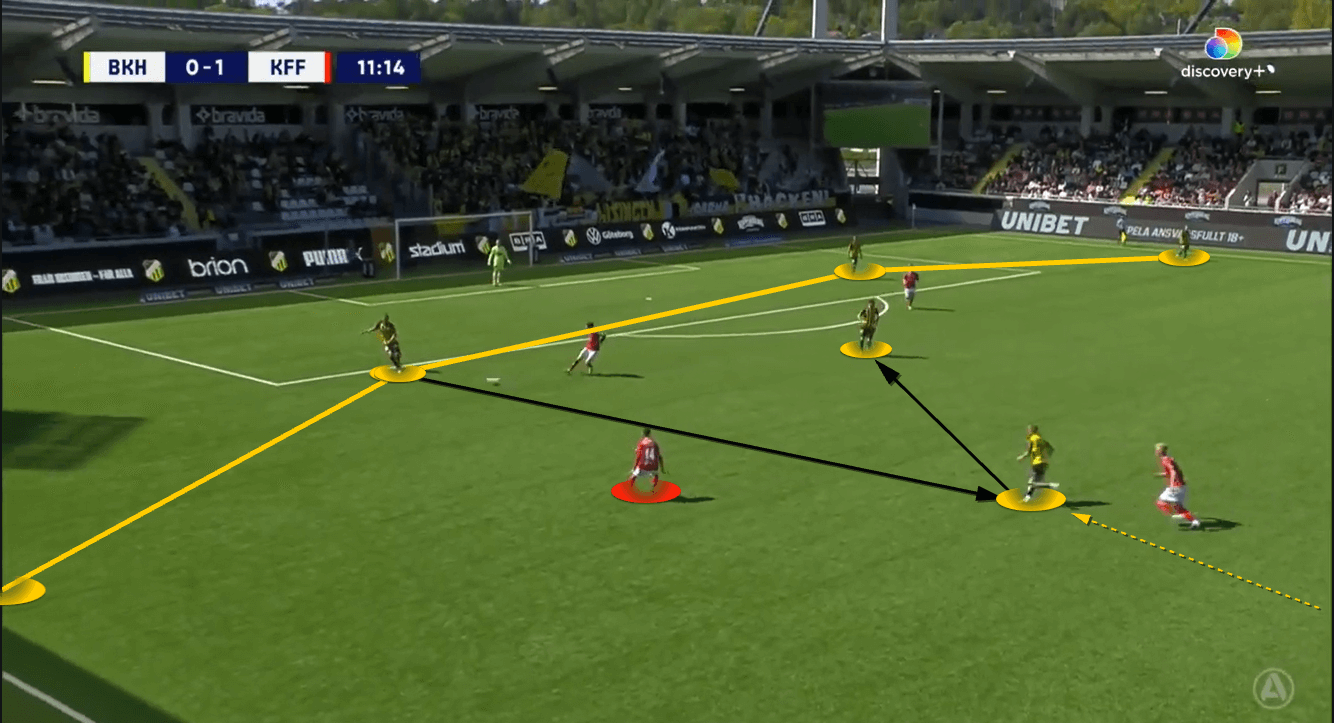
Häcken’s two central midfielders position themselves high in the build-up phase with the defensive midfielder typically dropping deep. This creates a large area of space between the opposition’s front line and their midfield.
The above image shows Häcken exploiting that space to progress the ball up the pitch. Häcken’s right centre-back has just received the ball from his left centre-back and has played a pass into his central midfielder. As the ball was travelling to the centre-back, the central midfielder, positioned high and in the half-space, made a run into the space he had created to receive the ball.
The central midfielder then bounces the ball to his defensive midfielder who can receive the ball facing forward. This simple way of progressing the ball up the pitch efficiently is all a result of the optimal positioning of the players.
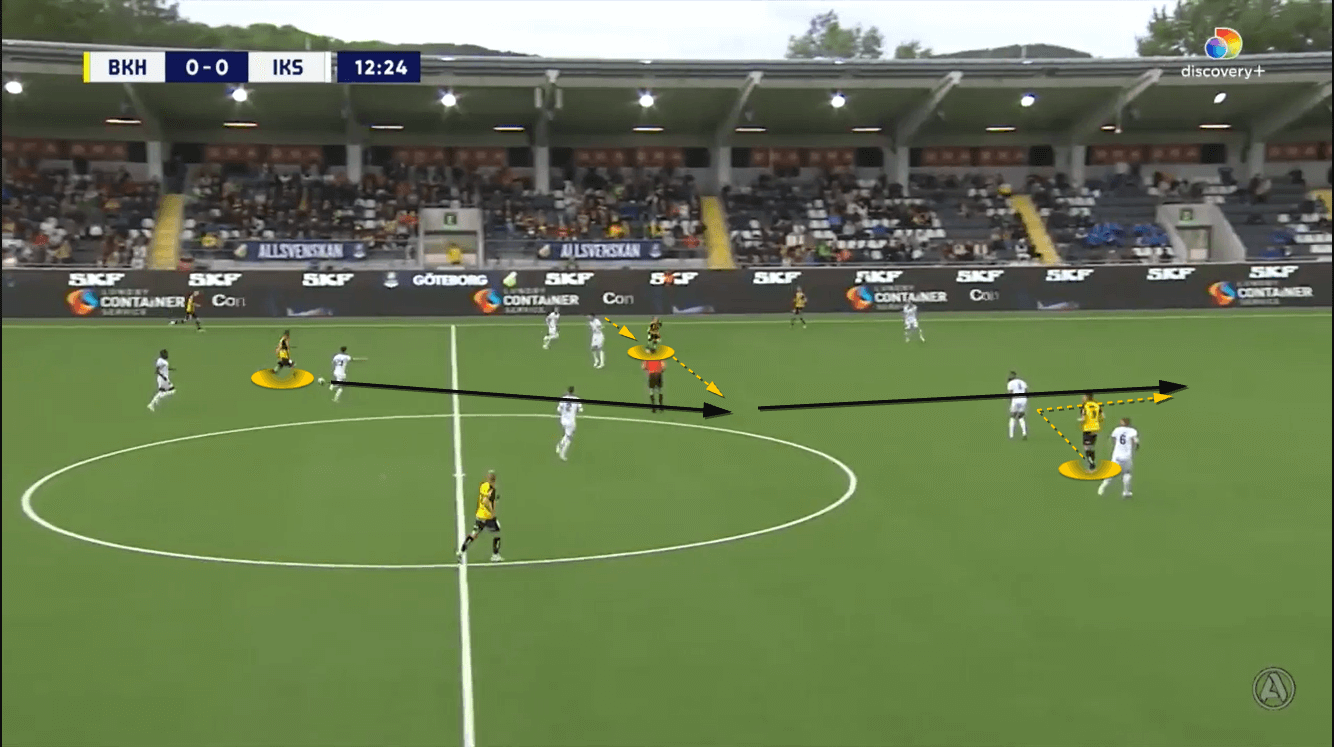
The willingness of Häcken’s centre-backs, in particular number ‘5’ Even Hovland, to be aggressive in possession allows them not only to break the first line of pressure but to create goalscoring opportunities from their build-up play.
Hovland, shown in the above image, can effectively dribble with the ball and does so here, attacking the space ahead of him. As he received the ball, the opposition’s number ‘9’ starts to loop his run to press him and keep him down to one side of the pitch. Hovland’s first touch is forward which immediately takes the forward out of the game.
Hovland’s defensive midfielder and central midfielder then make movements (shown above), which take defenders out of his path.

When the opposition eventually close Hovland down, he plays a pass to his central midfielder. The central midfielder has made an outside to inside run behind the opposition’s distracted midfielders. When he receives the ball he plays in his striker, Jeremejeff, who goes on to score.
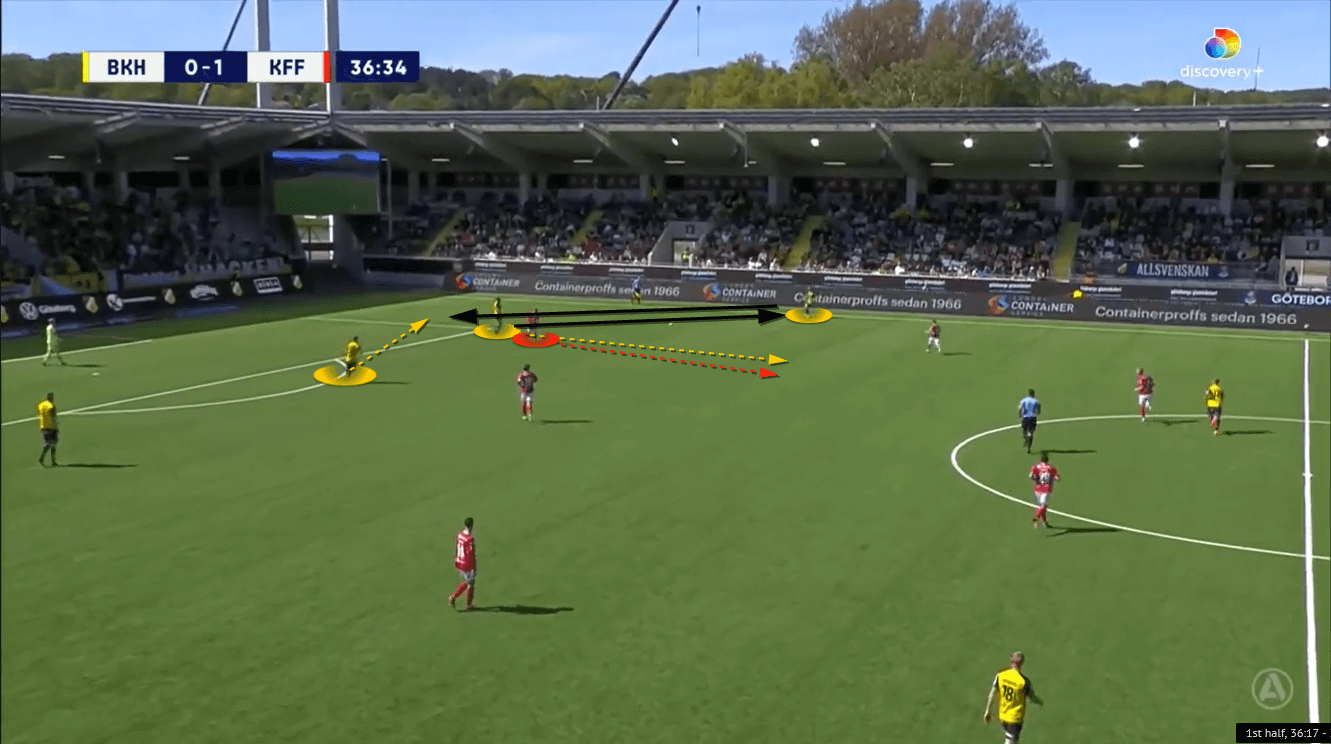
In this example of Hovland’s aggressive play in possession, he receives the ball and plays a pass into his full-back. Typically in this situation, a centre-back would drop or show wide to give his full-back, who is being pressed, an option.
Here, Hovland runs forward, into midfield, to be an option for a bounce pass from his teammate. On this occasion, the forward tracked his run which opened up the space for his defensive midfielder to receive the ball from his full-back relieving the pressure.
4-5-1 mid-block
In their previous two matches, Häcken have come up against a back three and have pressed differently in both games. Against Sirius, Häcken defended in a 4-4-2, whereas previously, against Malmö, they went with a 4-5-1. The following sections will analyse the strengths and weaknesses of both systems, beginning with their approach against Malmö.
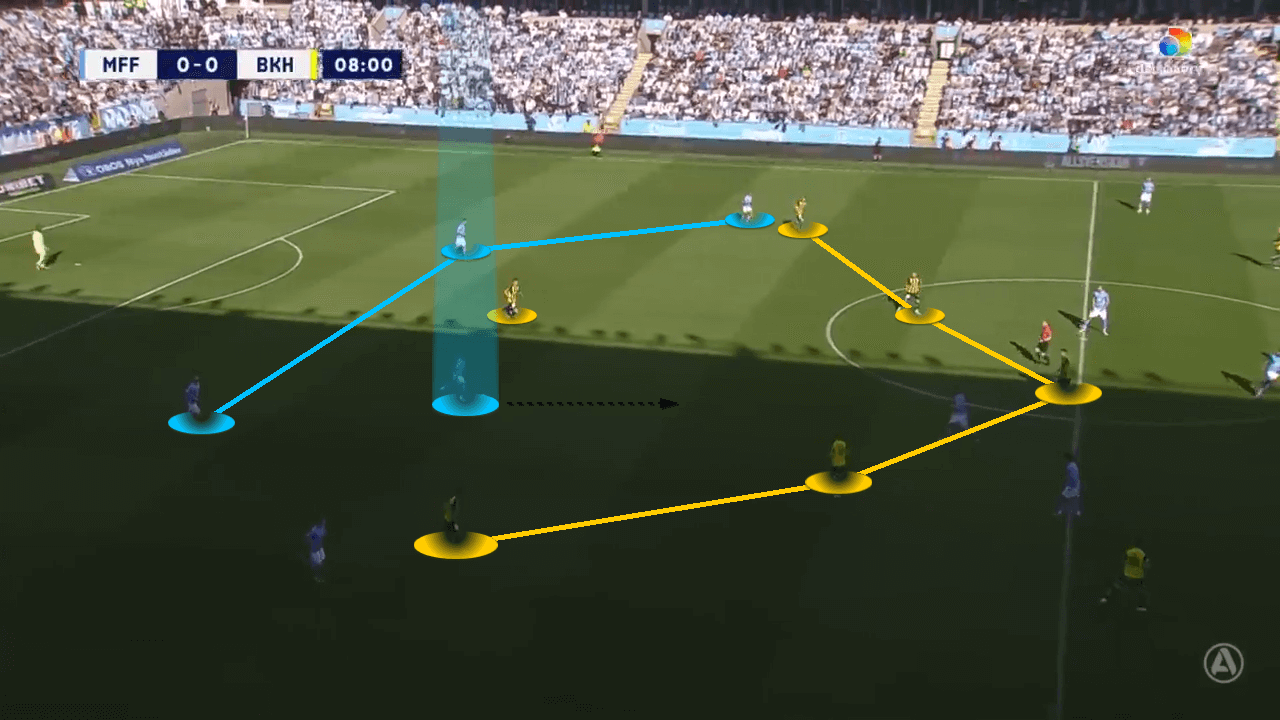
The above image shows that when Häcken dropped into a 4-5-1 mid-block, they pressed Malmö’s back-line with just one forward, Jeremejeff. When the forward applied any pressure, he cut the pitch in half, preventing the ball from being switched along the back-line but allowing a pass into the deepest Malmö midfielder.
The wide forwards and midfield three formed a ‘V’ shape in midfield whilst their back-line, just out of shot, remained connected as a four. When Malmö’s side centre-backs had the ball, the wide forwards positioned themselves to block passes into Malmö’s wingers.
The idea appeared to be to set a trap for the defensive midfielder in the central area. This was achieved by cutting off the centre-backs’ wide passing options and allowing the pivot midfielder to get on the ball. When in possession, he was encouraged to progress with the ball at his feet towards the centre of the ‘V’.
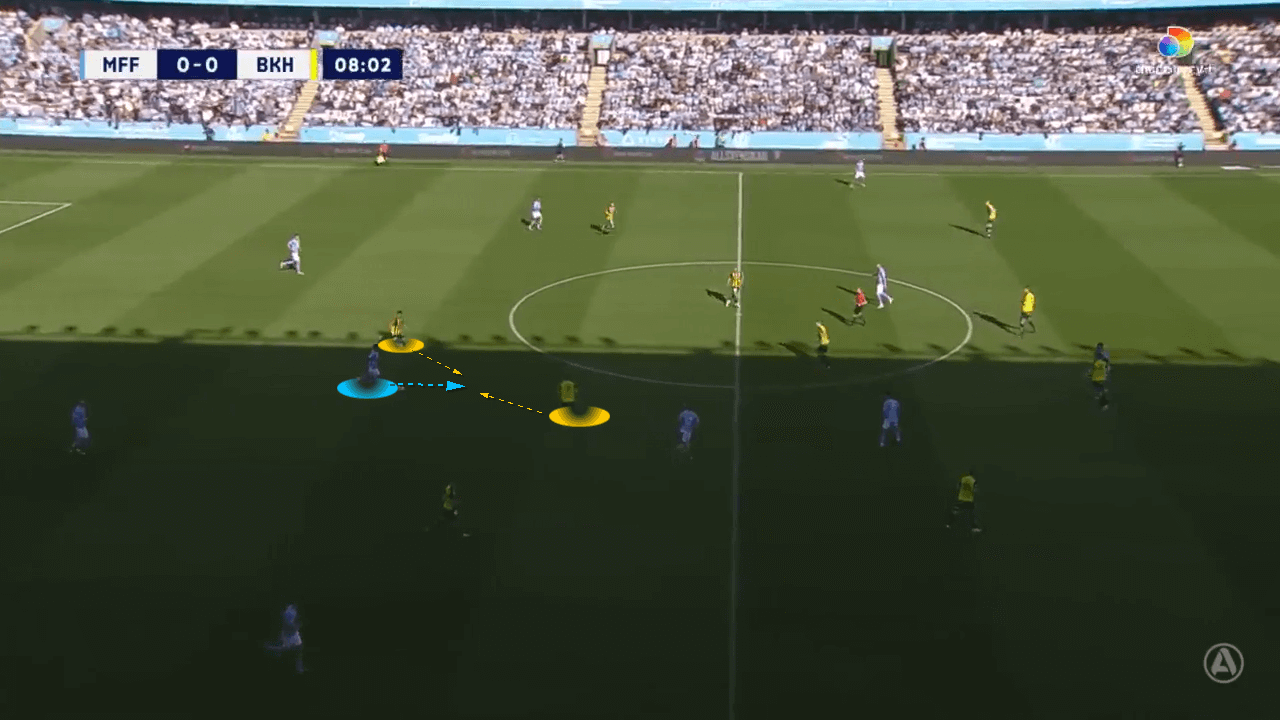
The single pivot player was allowed to progress 10-yards or so before one of the two central midfielders engaged with him. Häcken’s pivot, Samuel Gustafsson, never pressed the ball, instead, the former Serie A player always dropped to provide cover behind his central midfielder.
As the central midfielder stepped up, Jeremejeff pressured the pivot from behind to double up on the player. In the scenario shown above, the pivot disposed of the ball, albeit temporally. However, too often he was able to get his head up and find a pass to a teammate.
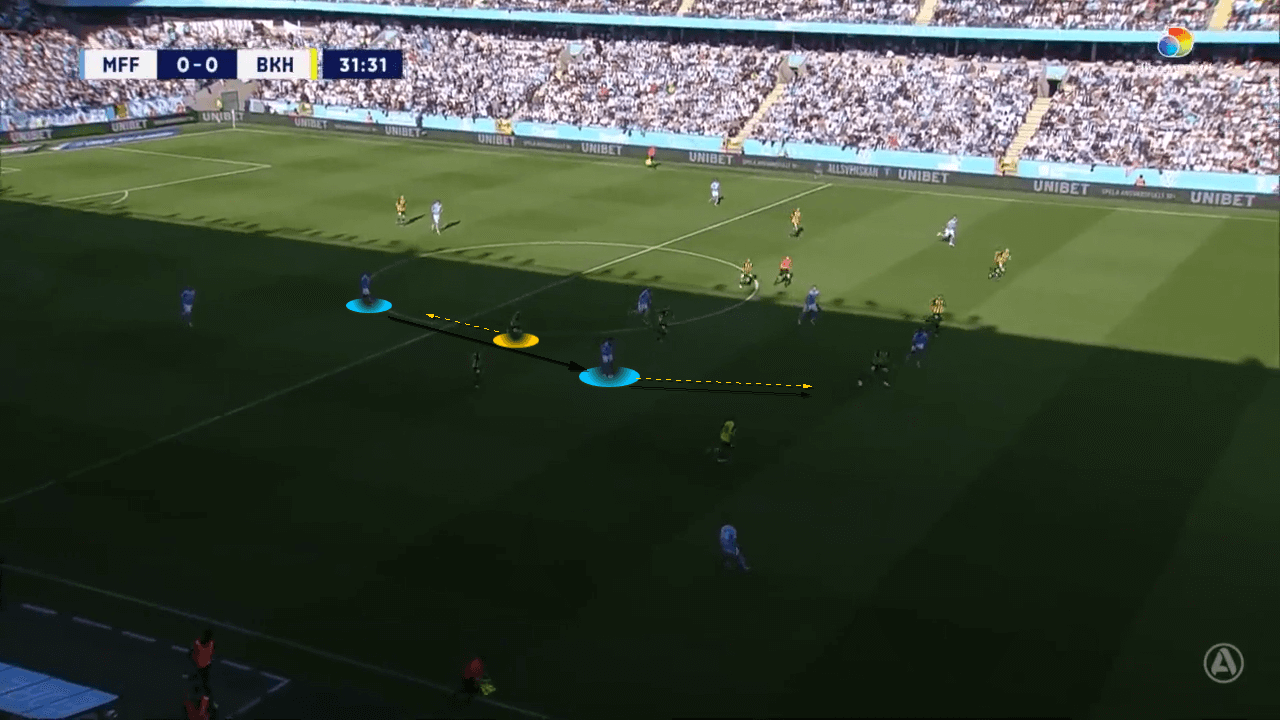
Although the midfield five created a compact barrier, Malmö’s midfielders and forwards could make runs on the blindside of Häcken’s midfielders and easily find pockets of space to get on the ball. Their movements combined with the passing ability of the player on the ball meant Malmö were able to receive behind the midfield too often. This was especially so when Jeremejeff was too far to apply pressure from behind on the pivot midfielder.
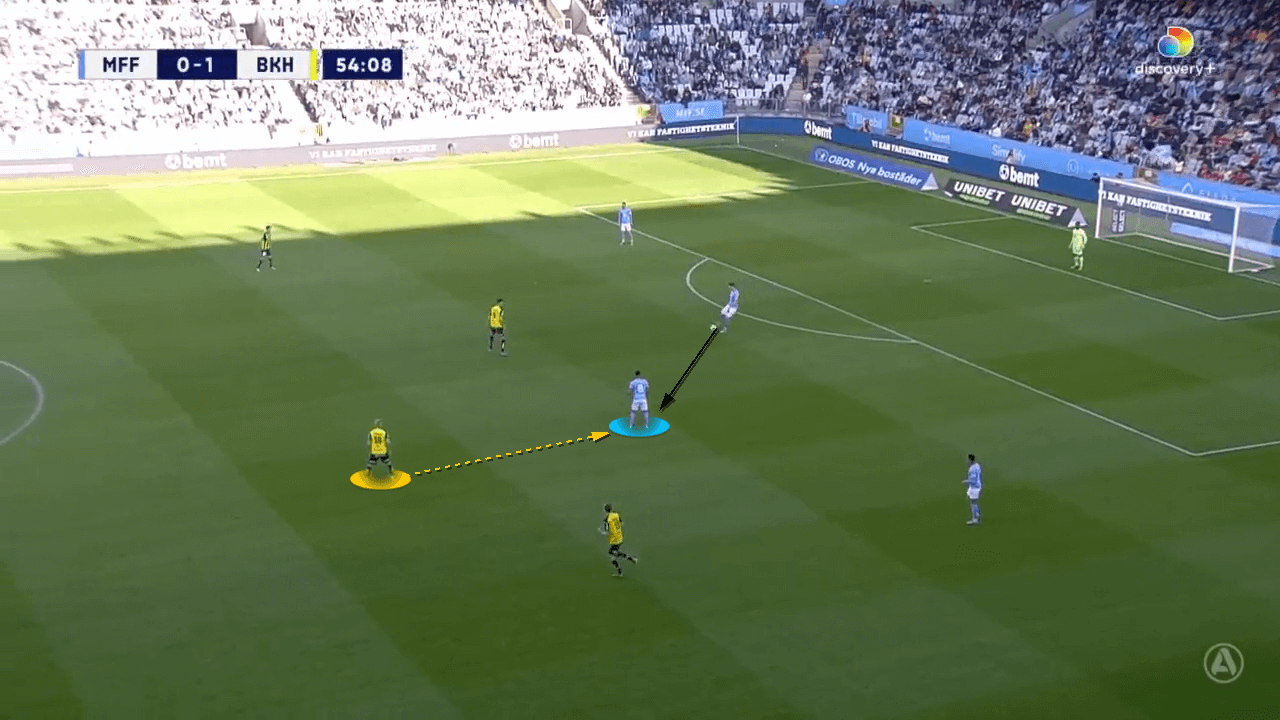
To combat this, in the second half, the pressure was applied earlier to the pivot when he received the ball. As the above image shows, Häcken’s central midfielder pressed the pivot much higher up the pitch and as soon as the ball was passed into him by the centre-back. The pressure forced the pivot into playing longer passes which were dealt with comfortably.
Pressing from a 4-4-2 mid-block
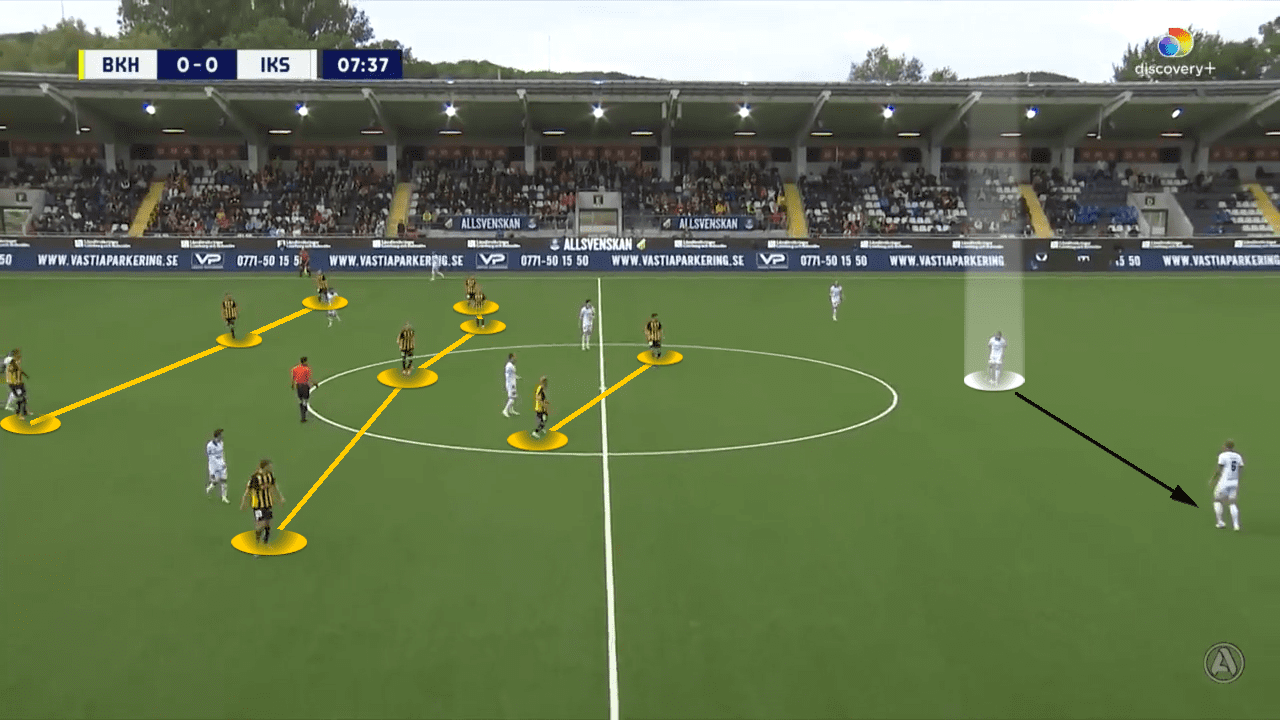
In their match against Sirius, Häcken deployed a 4-3-3 in possession and a 4-4-2 mid-block out of possession against Sirius’ 3-4-3. During Sirius’s build-up phase, Häcken dropped off into their own half and central midfielder, former Charlton Athletic man Mikkel Rygaard, positioned himself alongside Jeremejeff in a front two.
The front two were angled, with Rygaard slightly behind Jeremejeff, to encourage the central centre-back to pass to his right-footed, left centre-back. This pass was the pressing trigger for Häcken with Rygaard pressing the left centre-back as soon as the ball was played.
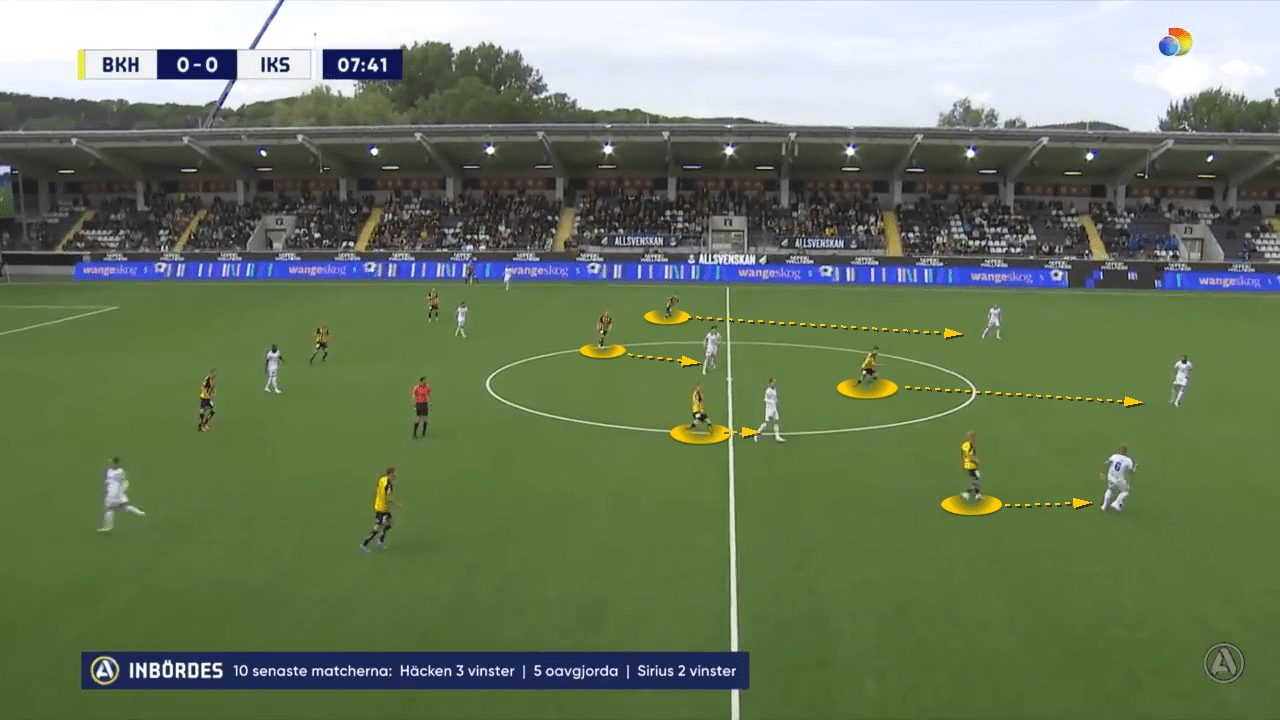
The above image shows the moments after the left centre-back has received the ball from his central centre back and is pressed by Rygaard. His immediate reaction when under pressure is to get the ball onto his favoured right foot and look inside the pitch.
As he does so, Jeremejeff presses the central centre-back, Häcken’s left-midfielder presses the right centre-back and their two central midfielders man-mark the two Sirius midfielders. This leaves Sirius with no passing options. Usually, this resulted in them turning over possession via a long ball but Häcken were also to dispossess them and create chances from this press.
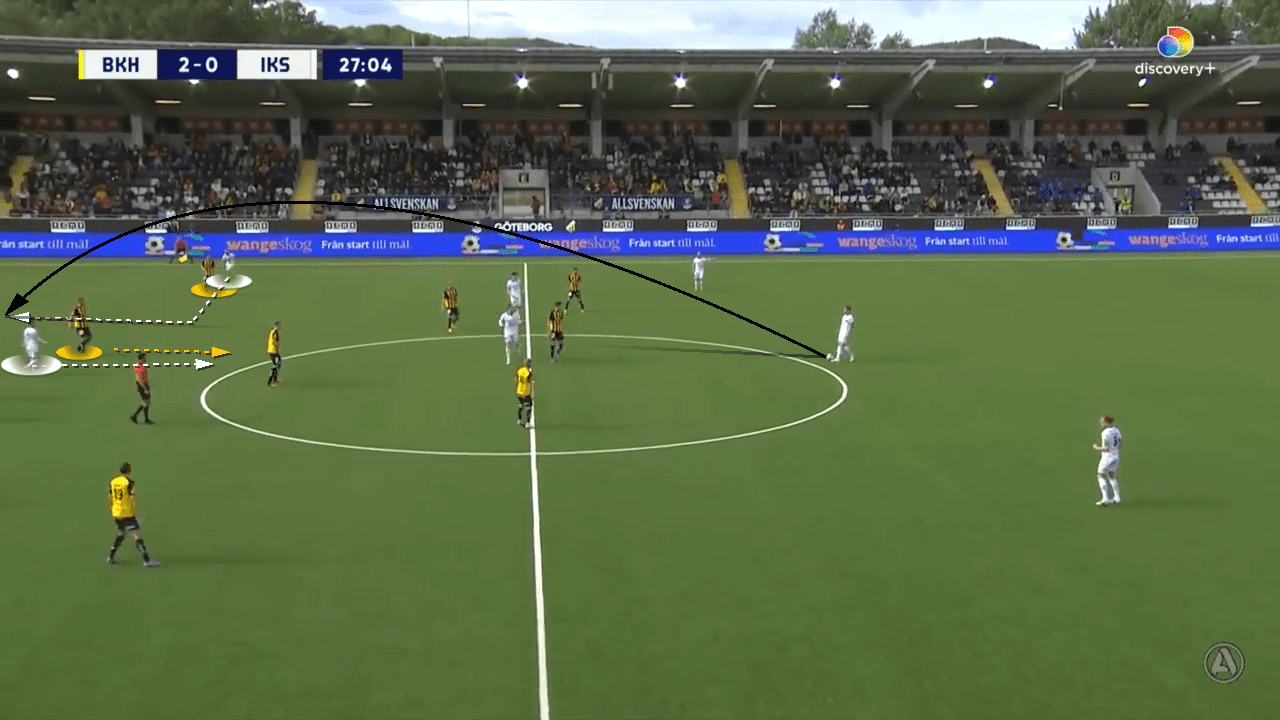
The positioning of the block, and the individual players, meant there was no room for Sirius to play through it and very little space to hit anything in-behind. This gave Häcken control of the match (until they were reduced to 10-men) without having to be in possession.
However, despite their control of the match, a momentary lapse of concentration meant they conceded whilst set in their mid-block. The above image shows the moments before the goal was conceded.
Sirius’ left centre back is in possession, with no passing options into midfield available, Häcken are anticipating the next pass being to the left centre back. Instead, he plays a long ball over the top.
With no pressure being put on the ball, Häcken’s back-line has been caught too high, leaving space for a dinked ball over the top. To make the situation worse, Sirius’s striker has made a movement towards the ball which is tracked by the centre-back. This creates even more space for the right-winger to make a run into.
As the right-winger makes a run across the defensive line, Häcken’s left-back, whose starting position is too wide, has switched off and let him run. The winger then cut in behind the centre-back, who had stepped up, and received the ball in behind before going on to score.
After the concession of the goal, the left-back adjusted his positioning to be further inside the pitch. This made sure the winger was always on the outside of him and allowed him to cover the space if his centre-back stepped up. Other than the one incident that led to the goal conceded, Häcken looked very comfortable and in control in their mid-block, creating more chances from it than they gave up.
Conclusion
After one-third of the season played, Häcken look like a serious threat to at least finish in the top three and claim one of Sweden’s European spots. They’re a very organised team who look comfortable without the ball but can also be the protagonist and take the game to teams when the situation demands it. Høgmo’s side have an impressive goalscoring record and their xG shows they are getting exactly what they deserve from an attacking point of view.
Their first game back after the international break against Hammarby, who could overtake them with a win, is one to look out for.






Comments